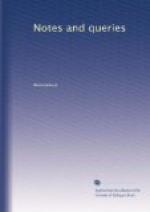“Abbatis pars prima notis que fulget
aliemis
Est vindelini pressa labore mei:
Cuius ego ingenium de vertice palladis
ortum
Crediderim. veniam tu mihi spira dabis.”
12. Is it not unquestionable that Heroldt’s Promptuarium Exemplorum was published at least as early as his Sermones? The type in both works is clearly identical, and the imprint in the latter, at the end of Serm. cxxxvi., vol. ii., is Colon. 1474, an edition unknown to very nearly all bibliographers. For instance, Panzer and Denis commence with that of Rostock, in 1476; Laire {325} with that of Cologne, 1478; and Maittaire with that of Nuremberg, in 1480. Different statements have been made as to the precise period when this humble-minded writer lived. Altamura (Bibl. Domin., pp. 147. 500.) places him in the year 1400. Quetif and Echard (i. 762.), Fabricius and Mansi (Bibl. Med. et inf. Latin.), prefer 1418, on the unstable ground of a testimony supposed to have proceeded from the author himself; for whatever confusion or depravation may have been introduced into subsequent impressions, the editio princeps, of which I have spoken, does not present to our view the alleged passage, viz., “a Christo autem transacti sunt millequadringenti decem et octo anni,” but most plainly, “M.cccc. & liij. anni.” (Serm. lxxxv., tom. ii.) To this same “Discipulus” Oudin (iii. 2654.), and Gerius in the Appendix to Cave (p. 187.), attribute the Speculorum Exemplorum, respecting which I have before proposed a Query; but I am convinced that they have confounded the Speculum with the Promptuarium. The former was first printed at Deventer, A.D. 1481, and the compiler of it enters upon his prologue in the following striking style: “Impressoria arte jamdudum longe lateque per orbem diffusa, multiplicatisque libris quarumcunque fere materiarum,” &c. He then expresses his surprise at the want of a good collection of Exempla; and why should we determine without evidence that he must have been Heroldus?
R.G.
* * * * *
FAIRFAX’S TASSO.
In a copy of Fairfax’s Godfrey of Bulloigne, ed. 1600 (the first), which I possess, there occurs a very curious variorum reading of the first stanza of the first book. The stanza, as it is given by Mr. Knight in his excellent modern editions, reads thus:
“The sacred armies and the godly
knight,
That the great sepulchre of Christ did
free,
I sing; much wrought his valour and foresight,
And in that glorious war much suffer’d
he;
In vain ’gainst him did hell oppose
her might,
In vain the Turks and Morians armed be;
His soldiers wild, to brawls
and mutines prest,
Reduced he to peace, so heaven
him blest.”
By holding up the leaf of my copy to the light, it is easy to see that the stanza stood originally as given above, but a cancel slip printed in precisely the same type as the rest of the book gives the following elegant variation:




